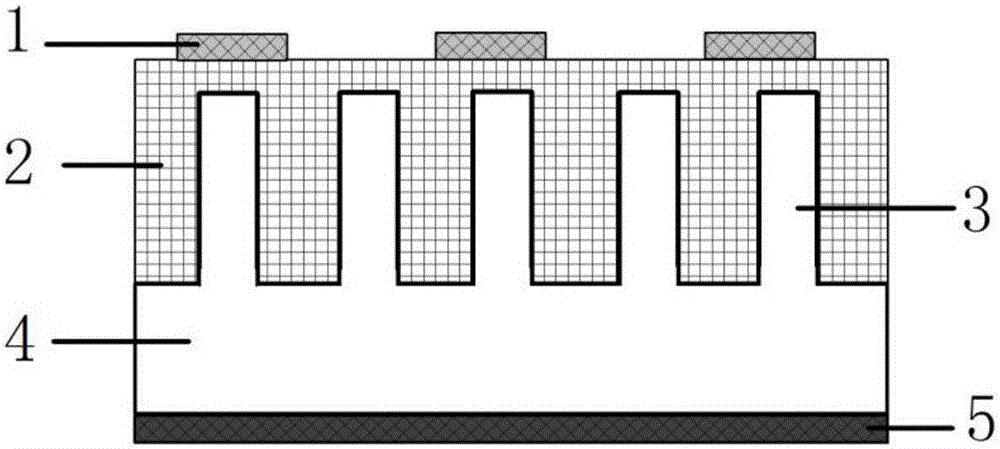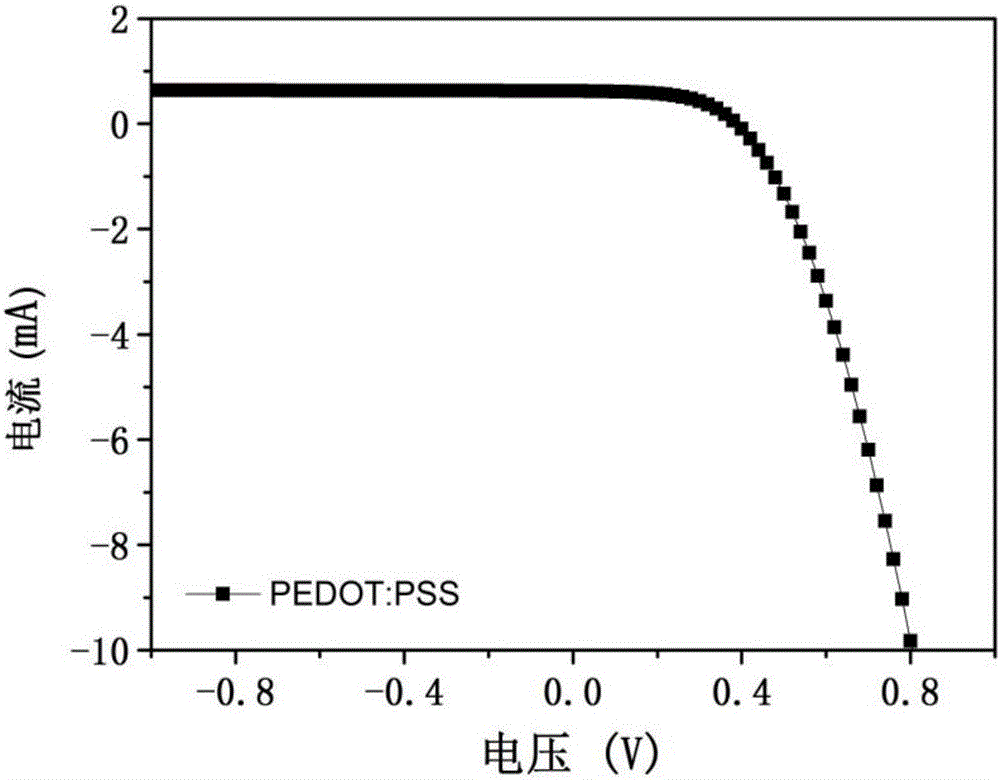Self-driven wide-spectral-response silicon-based hybrid heterojunction photoelectric sensor and preparation method therefor
A photoelectric sensor, wide-spectrum technology, applied in photovoltaic power generation, electric solid-state devices, semiconductor/solid-state device manufacturing, etc., can solve the problems of difficult oxide thickness and thin film, high device preparation cost, high dependence, etc., to reduce defects density of states, improved separation and transmission efficiency, and reduced fabrication costs
- Summary
- Abstract
- Description
- Claims
- Application Information
AI Technical Summary
Problems solved by technology
Method used
Image
Examples
Embodiment 1
[0050] This embodiment discloses a self-driven wide-spectrum response silicon-based hybrid heterojunction photosensor, which is an alkylated organic / inorganic hybrid heterojunction photosensor, including a metal back electrode 5 , N-type silicon substrate 4, N-type silicon nanowire array 3, organic polymer semiconductor film 2 and sensor anode 1 (front metal gate electrode).
[0051] The upper surface of the N-type silicon substrate 4 is etched into an N-type silicon nanowire array 3, and then a layer of organic polymer semiconductor film 2 is covered on the surface of the N-type silicon nanowire array 3, and the surface of the organic polymer semiconductor film 2 is provided with The positive electrode 1 of the sensor is used as the positive electrode of the battery; the lower surface of the N-type silicon substrate 4 is provided with a thin film as a metal back electrode 5, which can form a good ohmic contact with silicon and play a good role in collecting electrons.
[0052...
Embodiment 2
[0062] This embodiment discloses a method for preparing a self-driven wide-spectrum response silicon-based hybrid heterojunction photoelectric sensor, that is, the method for preparing the above-mentioned organic semiconductor film-silicon heterojunction photoelectric sensor, including the following steps:
[0063] S1, using the metal-assisted chemical reaction etching method to process the clean N-type single crystal silicon substrate to obtain the N-type silicon substrate 4 of the silicon nanowire array;
[0064] S2, using hydrofluoric acid (HF) to remove the oxide layer on the surface of the N-type silicon substrate 4 treated in step S1;
[0065] S3. Alkylation treatment is performed on the surface of the N-type silicon substrate 4 treated in step S2 to obtain a passivated surface of the N-type silicon nanowire array 3 structure.
[0066] S4. Uniformly spin coating an organic solution on the alkylated N-type silicon nanowire array 3 . In an inert atmosphere, under the cond...
Embodiment 3
[0073] This embodiment discloses a method for preparing a self-driven wide-spectrum response silicon-based hybrid heterojunction photoelectric sensor, that is, a method for preparing the above-mentioned organic semiconductor thin film PEDOT:PSS-silicon heterojunction photosensor:
[0074] SA1. Use commercialized double-sided polishing, N-type single crystal silicon wafer with a resistivity of 1-10 ohms per centimeter and a crystal orientation of 100; clean the silicon wafer with RCA standard cleaning method, and then dry it with nitrogen to obtain N-type silicon substrate;
[0075] Put the cleaned planar silicon substrate into 4.8M HF and 0.02M AgNO 3 In the mixed solution, silicon nanowire arrays with different lengths are obtained by controlling the reaction and different etching times at normal temperature. The length of the nanowires is about 10 min in the optimized process, the length of the nanowires is about 1 μm, and the distance between the nanowires is 50 nm to 450 ...
PUM
| Property | Measurement | Unit |
|---|---|---|
| length | aaaaa | aaaaa |
| thickness | aaaaa | aaaaa |
| thickness | aaaaa | aaaaa |
Abstract
Description
Claims
Application Information
 Login to View More
Login to View More - R&D
- Intellectual Property
- Life Sciences
- Materials
- Tech Scout
- Unparalleled Data Quality
- Higher Quality Content
- 60% Fewer Hallucinations
Browse by: Latest US Patents, China's latest patents, Technical Efficacy Thesaurus, Application Domain, Technology Topic, Popular Technical Reports.
© 2025 PatSnap. All rights reserved.Legal|Privacy policy|Modern Slavery Act Transparency Statement|Sitemap|About US| Contact US: help@patsnap.com



